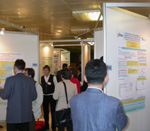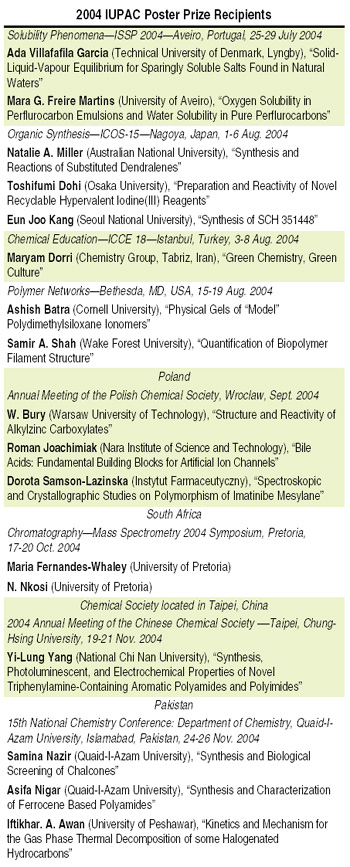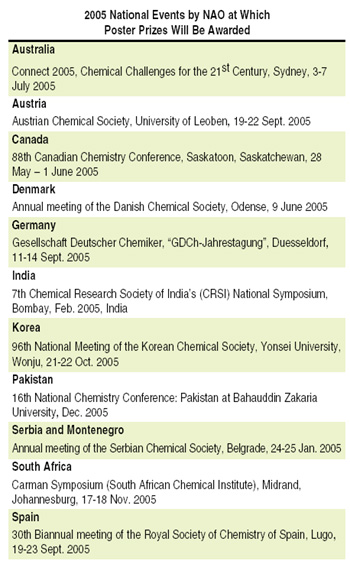|
|
Vol.
27 No. 3
May-June 2005
| IUPAC Wire |
| |
News and information on IUPAC, its fellows, and members organizations
See also www.iupac.org/news |
IUPAC Poster Prizes
With the recent advent of the IUPAC Poster Prize program, National Adhering Organizations and eligible IUPAC-sponsored conferences gained a strategic tool to encourage interest in conferences among young chemists. The Poster Prizes recognize outstanding poster presentations at IUPAC Congresses, at IUPAC division/standing committee-sponsored conferences, and at designated national meetings. Each NAO may pick one conference a year at which to award IUPAC Poster Prizes.
 |
As
explained by the secretary general David StC. Black in his
column in the January-February 2005
CI (p. 2), division or standing committee-sponsored,
or so-called “core,” conferences are specifically
driven by IUPAC divisions and standing committee to the extent
that they take responsibility for ensuring the continuity
of a series. This usually means that the committee is involved
in the selection of the organizers and the location of future
conferences to ensure geographical diversity. The committee
may also review the conference program, help select the plenary
and invited lecturers, and assist in terms of promotion. With
these guidelines in mind, divisions and standing committees
benefit from the Poster Prizes program because it provides
an extra incentive to maintain IUPAC’s relationship
with recognized conferences throughout the world. Conferences
sponsored by IUPAC and national meetings of NAOs also benefit
by being able to offer a prize that is associated with IUPAC,
which often bolsters the participation in and credibility
of a meeting.
The IUPAC Poster Prizes program was implemented in 2004 following a suggestion from President Leiv Sydnes. The Executive Committee officially approved the program at its meeting in April 2004. It was felt that implementing such a program would benefit IUPAC and provide incentives to younger chemists to attend conferences they might not otherwise attend. The program will also serve as a means for recognizing IUPAC’s international activities.
Each eligible conference that chooses to implement the IUPAC
Poster Prizes typically awards two prizes. The conference
organizers oversee the selection of prizewinners. Each prize
recipient receives a certificate signed by the IUPAC president,
a copy of the Gold Book (Compendium of Chemical Terminology),
and a two-year subscription to CI.
In 2004, prizes were awarded at four international conferences and four national meetings even though the program was only initiated in mid-July. The astute reader of CI might have noticed mentions of these poster prizes in recent issues. The 2004 recipients, all listed in the table below, are congratulated for their poster presentations.

It has been encouraging to see that NAOs and conference organizers appreciate IUPAC’s efforts to stimulate outstanding poster presentations. Professor Mike Scurrell, who is organizing the 2005 Carman Symposium, hosted by the South African Chemical Institute, has responded warmly to this program. While informing the Secretariat that the conference will award IUPAC Poster Prizes on behalf of South Africa’s NAO, he wrote:
“As a regular organizer of conferences we are well aware of the importance of awarding prizes for poster presentations, particularly for younger contributors. Over the past few years we have been astounded by the very significant increase in the quality of posters that are now a far cry from some of the hastily compiled sheets of research results that were very common in the past. The lure of a prize, be it a medal, cash, certificate, or similar really can focus the mind on producing a high-quality product and can ensure a high state of preparedness on the part of the presenter when the poster session is held, in order that some meaningful discussion and interaction can take place. We assess poster quality not only on the appearance of the item, which, with modern software can achieve a very impressive level, but also on the scientific content and the way the poster medium is used to convey the essential message quickly and accurately. We also acknowledge the ability of the presenter(s) to engage with those viewing the poster. In the specific case of IUPAC prizes, there is the additional benefit of helping us bring to everyone’s attention the work of the organization by raising awareness of the Union at conference gatherings.”
So
far in 2005, 13 NAOs have reported that IUPAC Poster Prizes
will be awarded at a national event; these are listed in the
table below or <www.iupac.org/symposia/nao/2005.html>

Starting
with this issue of CI, each IUPAC-sponsored conference
eligible to award poster prizes will be flagged in the Mark
Your Calendar section, as well as online. Over the most
typical two to three-year cycle, no less than 27 “core”
series will be eligible to award IUPAC poster prizes.
Details and guidelines can be found at <www.iupac.org/news/archives/2004/poster_prizes.html>.
Page
last modified 21 April 2005.
Copyright © 2003-2005 International Union of Pure and
Applied Chemistry.
Questions regarding the website, please contact [email protected]
|